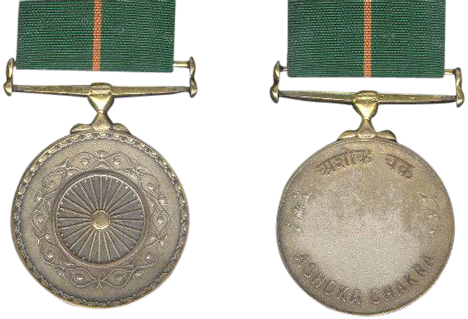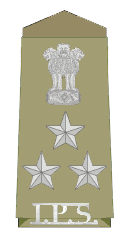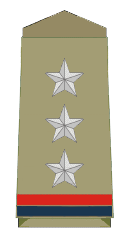|
Gajender Singh Bisht
Gajender Singh Bisht (1 July 1972 – 28 November 2008) was an NSG commando and Havildar (Sergeant) who was killed during the 2008 Mumbai attacks. His act of bravery was honored with the Ashoka Chakra award by the President of India on India's 60th Republic Day on 26 January 2009. Childhood Hailing from Ganeshpur in Dehradun, Uttarakhand, young Gajender Singh studied at the Janata Inter College in Naya Gaon. He was remembered by his teachers as a disciplined student who participated in every event organised in the school, sports or cultural activities. He had a particular interest in boxing. Operation Black Tornado Gajender Singh was a member of the National Security Guard’s 51 Special Action Group. He was part of the team of NSG commandos who were fast-roped onto the roof of Nariman House in an operation to neutralize the terrorists inside who were holding at least six hostages. According to Jyoti Krishna Dutt, Director General of the NSG, Singh was leading one of the te ... [...More Info...] [...Related Items...] OR: [Wikipedia] [Google] [Baidu] |
Havildar
Havildar or havaldar ( Hindustani: or (Devanagari), (Perso-Arabic)) is a rank in the Indian and Pakistani armies, equivalent to sergeant. It is not used in cavalry and armoured units, where the equivalent is daffadar. Like a British sergeant, a havildar wears three rank chevrons. History "Havildar" is a Persian word in origin and means "person in charge", or more loosely "chief", from the Arabic ("charge", "responsibility") and the Persian (dâr, "holder"). Historically, a havildar was a senior commander, being in charge of a fort during the times of the Mughal Empire. It was used as the equivalent of a sergeant in the British Indian Army, which has led to its current usage. Appointments Indian Army Havildars could be further appointed to positions of higher authority. The appointments of company quartermaster havildar and company havildar major existed in the British Indian Army. Historically, the two senior-most havildars of a company became the CQMH and the CHM. How ... [...More Info...] [...Related Items...] OR: [Wikipedia] [Google] [Baidu] |
Ashoka Chakra (military Decoration)
The Ashoka Chakra () is India's highest peacetime military decoration. It is the peacetime equivalent of the Param Vir Chakra and is awarded for the "most conspicuous bravery or some daring or pre-eminent valour or self-sacrifice". The decoration may be awarded either to military personnel or civilians by the Government of India. The circular medal consists of Ashoka Chakra surrounded by a lotus wreath on the front. The obverse consists of "Ashoka Chakra" written in Devanagari along the upper edge on the medal and in English along the lower rim. It is suspended by a straight bar suspender from a green ribbon with a central saffron stripe. , there have been 86 recipients of the award. Of these, 68 have been posthumous recipients, and 17 have been civilians. Havildar Bachittar Singh of the Indian Army was the first recipient of the award, in 1952. D. K. Jatar, a pilot of Air India's Kashmir Princess was the first civilian recipient of the award, in 1955. Only two women have e ... [...More Info...] [...Related Items...] OR: [Wikipedia] [Google] [Baidu] |
2008 Deaths
This is a list of lists of deaths of notable people, organized by year. New deaths articles are added to their respective month (e.g., Deaths in ) and then linked below. 2025 2024 2023 2022 2021 2020 2019 2018 2017 2016 2015 2014 2013 2012 2011 2010 2009 2008 2007 2006 2005 2004 2003 2002 2001 2000 1999 1998 1997 1996 1995 1994 1993 1992 1991 1990 1989 1988 1987 1986 Earlier years ''Deaths in years earlier than this can usually be found in the List of years, main articles of the years.'' See also * Lists of deaths by day * :Deaths by year, Deaths by year (category) {{DEFAULTSORT:deaths by year Lists of deaths by year, ... [...More Info...] [...Related Items...] OR: [Wikipedia] [Google] [Baidu] |
Tukaram Omble
Tukaram Omble AC ( 1954 – 27 November 2008) was an Indian police officer and a former member of the Indian army who served as an assistant sub-inspector (ASI) of the Mumbai Police. He was martyred in action during the 26/11 attacks, at Girgaum Chowpatty in Mumbai. The Indian government posthumously honoured Omble on 26 January 2009 with the Ashoka Chakra, the country's highest peacetime military award. Biography Omble joined the Mumbai police as a constable in 1991 after retiring from the Indian Army's Signal Corps as a naik. He was an ASI in the Mumbai Police. On 26 November he and his team were guarding a checkpoint when they were approached by two terrorists in a hijacked vehicle. After an initial shootout, one of the terrorists died inside the vehicle. The other terrorist, Ajmal Kasab, exited the vehicle and feigned surrender. As an unarmed Omble approached him, Kasab got up and opened fire. Omble stood in front of him and held on to the barrel of Kasab's rifle, wh ... [...More Info...] [...Related Items...] OR: [Wikipedia] [Google] [Baidu] |
Ashok Kamte
Ashok Kamte AC (23 February 1965 – 26 November 2008) was an Indian police officer, serving as the Additional Commissioner of the Mumbai Police supervising the Eastern region. He was killed in action during the 2008 Mumbai attacks. He was posthumously given the Ashoka Chakra on 26 January 2009. Personal background The son of Lieutenant-Colonel Marutirao Narayanrao Kamte (August 22, 1929 – 13 January 2014) and his first wife Perm Kamte, Ashok Kamte was born on 23 February 1965 in a Marathi family with a long tradition of police service. His great-grandfather, Rao Bahadur Marutirao Kamte KPM IPM, had served in the Indian Imperial Police from 1895 to 1923, while his grandfather Narayanrao also joined the Imperial Police in 1923, eventually serving as the first Indian Inspector-General (Director-General) of the Maharashtra Police from 1947 to 1955. Kamte's schooling consisted of The Rajkumar College, Rajkot Rajkot () is the fourth-largest city in the Indian state ... [...More Info...] [...Related Items...] OR: [Wikipedia] [Google] [Baidu] |
Vijay Salaskar
Vijay Salaskar, AC (5 April 1957 – 26 November 2008) was an Indian police inspector and encounter specialist with the Mumbai police. He was widely credited with killing 75–80 criminals in encounters, most of which were members of the Arun Gawli gang. Salaskar was killed in action during the 2008 Mumbai attacks, with captured terrorist Ajmal Amir Kasab claiming responsibility for the killing. Before his death Salaskar was head of the Anti-Extortion Cell, Mumbai. Retrieved 27 November 2008 His patriotism and bravery was honoured with the Ashoka Chakra on 26 January 2009. Early life and his career He joined Bombay Police (now Mumbai Police) as a sub inspector in 1983. ''India Today'' reports Salaskar's first lethal encounter occurred during his first year of appointment, when he shot dead Raja Shahabuddin, known to police on several counts. Salaskar, who was reportedly sidelined for the last two years for unearthing the gutka-underworld nexus, was recently attached to the ... [...More Info...] [...Related Items...] OR: [Wikipedia] [Google] [Baidu] |
Sandeep Unnikrishnan
Major Sandeep Unnikrishnan, Ashoka Chakra (military decoration), AC (15 March 1977 – 28 November 2008) was an Indian Army officer, who was serving in the 51 Special Action Group of the National Security Guards, National Security Guard on deputation. He was killed in action during the 2008 Mumbai attacks and was posthumously awarded the Ashoka Chakra Award, Ashoka Chakra, India's highest peacetime gallantry award, on 26 January 2009. Early and personal life Maj. Sandeep Unnikrishnan, AC(P) came from a Malayali family residing in Bangalore, where they had moved from Kozhikode district, Kozhikode, Kerala . He was the only son of retired ISRO officer K.Unnikrishnan and Dhanalakshmi Unnikrishnan. Maj. Unnikrishnan studied at The Frank Anthony Public School, Bangalore, graduating in 1995 in the Indian School Certificate, ISC Science stream. He wanted to join the armed forces from childhood. He was married to Neha. Military career Maj. Sandeep Unnikrishnan, AC(P) joined the Nationa ... [...More Info...] [...Related Items...] OR: [Wikipedia] [Google] [Baidu] |
Hemant Karkare
Hemant Kamlakar Karkare, () (12 December 1954 – 26 November 2008) was the chief of the Mumbai Anti-Terrorism Squad (ATS). He was killed in action during the 2008 Mumbai attacks. In 2009, he was posthumously given the Ashoka Chakra, India's highest peacetime gallantry decoration. Karkare succeeded K. P. Raghuvanshi as the Chief of ATS in January 2008 and was eventually succeeded by Raghuvanshi after he was shot dead on 26 November 2008. He was credited with solving the serial bombing cases in Thane, Vashi and Panvel, and led the investigation of the 2008 Malegaon blasts. Early and personal life Hemant Karkare was born in a Maharashtrian family. He was married to Kavita Karkare (1957–2014), a college professor. They are the parents of two daughters and a son. Education and career Karkare did his primary schooling from Chittranjan Das Municipal Primary School, Wardha and then received his middle school and high school education from New English High School, Nagpur. He ... [...More Info...] [...Related Items...] OR: [Wikipedia] [Google] [Baidu] |
Nariman House
The Nariman House, designated as a Chabad house (), is a five-storey landmark in the Colaba area of South Mumbai, Maharashtra, India. The building was home to a Chabad house, a Hasidic Jewish outreach centre run by Gavriel and Rivka Holtzberg, who had owned the building since around 2006. The centre had an educational center, a synagogue, offered drug prevention services, and a hostel. The building was one of the sites of the November 2008 Mumbai terrorist attacks and six of its occupants, including Holtzberg and his wife, who was six months pregnant, were killed. Their two-year-old son Moshe survived the attack after being rescued by his Indian nanny, Sandra Samuel. Chabad House The Chabad house, located at 5 Hormusji Street, Colaba, is one of eight synagogues in Mumbai and has been described as the epicentre of the Jewish community in the city. It is one of 4,000 such houses in 73 countries, typically run by husband-and-wife couples. In 2003, this Chabad House, the firs ... [...More Info...] [...Related Items...] OR: [Wikipedia] [Google] [Baidu] |
Fast-roping
Fast-roping is a technique for descending a thick rope, allowing troops to deploy from a helicopter in places where the aircraft cannot touch down. The person holds onto the rope with gloved hands (with or without using their feet) and slides down it. Several people can slide down the same rope simultaneously, provided that there is a gap of about between them, so that each one has time to get out of the way when they reach the ground. Fast roping is quicker than abseiling, abseiling (rappelling), although more dangerous, particularly if the person is carrying a heavy load, because the rope is not attached to them with a Climbing equipment#Descenders, descender. The technique is particularly useful for Marines, naval infantry, who can use it to board ships at sea. History The technique was first developed by the UK with British rope manufacturer Marlow Ropes, and first used in combat during the Falklands War. The original rope was made of thick nylon that could be used in a m ... [...More Info...] [...Related Items...] OR: [Wikipedia] [Google] [Baidu] |
National Security Guard
The National Security Guard (NSG) is a central armed police force in India under the Ministry of Home Affairs. It is the primary counter-terrorism force of the Government of India. It was founded on 16 October 1984, following Operation Blue Star, to combat terrorist activities and protect states against internal disturbances. The formation of the NSG was formalised in the Parliament of India under the National Security Guard Act, 1986. NSG personnel are recruited from both the Indian Army and Central Armed Police Forces. History The NSG was established in the wake of 1984 Operation Blue Star, and the high collateral damage to Golden Temple, and civilian and military collateral casualties. Since its founding the NSG has been deployed in the Punjab in 1986, and Jammu and Kashmir. Some of the NSG's known operations include: * 29–30 April 1986: About 300 NSG commandos and 700 Border Security Force troops stormed the Golden Temple in Operation Black Thunder I. The Temple ... [...More Info...] [...Related Items...] OR: [Wikipedia] [Google] [Baidu] |
Uttarakhand
Uttarakhand (, ), also known as Uttaranchal ( ; List of renamed places in India, the official name until 2007), is a States and union territories of India, state in North India, northern India. The state is bordered by Himachal Pradesh to the northwest, Tibet to the north, Nepal to the east, Uttar Pradesh to the south and southeast, with a small part touching Haryana in the west. Uttarakhand has a total area of , equal to 1.6% of the total area of India. Dehradun serves as the state capital, with Nainital being the judicial capital. The state is divided into two divisions, Garhwal division, Garhwal and Kumaon division, Kumaon, with a total of List of districts of Uttarakhand, 13 districts. The forest cover in the state is 45.4% of the state's geographical area. The cultivable area is 16% of the total geographical area. The two major rivers of the state, the Ganges and its tributary Yamuna, originate from the Gangotri and Yamunotri glaciers respectively. Ranked 6th among the Top 1 ... [...More Info...] [...Related Items...] OR: [Wikipedia] [Google] [Baidu] |







